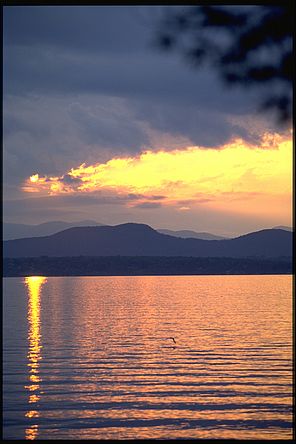The Color of Water
August 2010

A friend recently commented on how different the water of Lake Champlain looked compared to the famous deep blue color of the Mediterranean Sea. The observation prompted me to remember the turquoise of the lakes in Glacier National Park in Montana. Water bodies can take on many different colors. In New York State alone, one can find White Lake, Green Lake, Silver Lake, Black Lake, and Lake Clear. Even Lake Champlain itself will appear to be a different color depending on the time of day, the season, or the part of the lake being studied. How can water take on so many different hues? And what exactly is the color of water?
To begin to understand the color of lakes we must first start with a common idea of what ‘color’ is. The internet exhibit Causes of Color notes, “Visible light is merely a small part of the full electromagnetic spectrum… We can detect the range of light spectrum from about 400 nanometers (violet) to about 700 nanometers (red). We perceive this range of light wavelengths as a smoothly varying rainbow of colors, otherwise known as the visual spectrum.” Pure white light combines all colors that we perceive.
Two different processes help create color in water. Different wavelengths can be removed from white light, and they can be reflected preferentially.
The true color of pure water results from other colors being lost. Anyone looking at Lake Champlain would likely say it was blue, but someone with water cupped in their hand would describe the water as clear.
Pure water is very weakly blue because it absorbs light in the red wavelength. The energy of the light is converted into vibrational energy in the Oxygen-Hydrogen bond of the water molecule itself according to researchers at Dartmouth.
To identify the color of water the researchers need to look through long narrow tubes filled with water. Light passing through ten feet of water loses less than 50% of its red light. Therefore, if there’s not enough water, the color won’t show, and a mere handful seems clear.
Since observing the true color of water requires a viewer to look through the water, the blue would most easily be observed if you were looking up from within the lake. So why does water also appear blue to an observer outside of the lake?
Blue wavelengths are preferentially reflected from within the water column as well. When light waves move through a medium, air or water, they can run into particles that are smaller than the length of the wave. When this happens, blue light, with its shorter wavelength, is scattered more than red light. Therefore, it seems to be coming from every area of the water. The same phenomena (called Rayleigh scattering) is responsible for blue being the predominant color of the sky.
Water is also colored by simple reflection of the sky’s color. Sky reflection occurs most frequently when the sun is lower on the horizon. Then the sun’s rays bounce off the water as they hit due to the high angle of impact. When the sun is directly above the water, more of the light is absorbed.
Differences in water color between lakes are usually caused by differences in substances within the water. Algae in the water may give it a greener tint. Sediments and clays cause browner water. Tannic acids leached from leaves, conifer needles, and decaying organic matter, produce black waters.
The turquoise blue of the lakes in Glacier National Park are caused by ground up bits of rock and sediment referred to as “glacial flour”. The movement of the nearby glaciers erodes the bedrock providing a continuous source of “flour” to the lakes. The very small particles become suspended in the water column and the water can sometimes even seem milky. Additional scattering caused by glacial flour shifts the spectrum of light toward green, yielding the more turquoise color.
In short, though water has a color, the lake’s color is ever varied. Throughout a year the lake color will change depending on whether recent rains have washed in sediment or depending on the presence or absence of algae. Within a moment, the wind can ripple the shore of the lake affecting the amount of blue reflected. The simple movement of the observer up or down in elevation or the sun up or down in the sky will change the reflections of the lake. An artist could spend a lifetime trying to capture the ever changing interplay of light and shadow and color on Lake Champlain.
Lake Look is a monthly natural history column produced by the Lake Champlain Committee (LCC). Formed in 1963, LCC is the only bi-state organization solely dedicated to protecting Lake Champlain’s health and accessibility. LCC uses science-based advocacy, education, and collaborative action to protect and restore water quality, safeguard natural habitats, foster stewardship, and ensure recreational access.
Get involved by joining LCC using our website secure form (at www.lakechamplaincommittee.org), or mail your contribution (Lake Champlain Committee, 208 Flynn Avenue - BLDG 3 - STUDIO 3-F, Burlington, VT 05401), or contact us at (802) 658-1414, or lcc@lakechamplaincommittee.org for more information.
